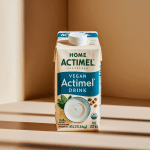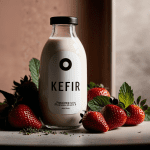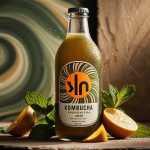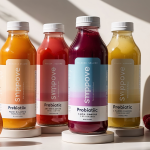This recipe will help you create a delicious, dairy-free kefir inspired by Lifeway, using plant-based ingredients. You can use soy milk or almond milk as your base, and it will be packed with probiotics!
Ingredients
- 4 cups unsweetened soy milk (or almond milk)
- 1/2 cup unsweetened coconut yogurt (with live cultures) or 1-2 vegan probiotic capsules
- 1-2 tablespoons maple syrup or agave syrup (optional, for sweetness)
- Flavorings (optional):
- For Chocolate Flavor: 2 tablespoons unsweetened cocoa powder
- For Fruity Flavor: 1 cup fresh or frozen fruits (like strawberries, blueberries, or mango)
Instructions
Prepare the Base:
- In a blender, combine the unsweetened soy milk and coconut yogurt (or the contents of the probiotic capsules). Blend until smooth and well mixed.
Add Sweetener and Flavorings:
- If desired, add maple syrup or agave syrup for sweetness. For chocolate flavor, add cocoa powder; for fruity flavor, add your choice of fresh or frozen fruits. Blend again until all ingredients are well combined and smooth.
Fermentation:
- Pour the mixture into a clean glass jar or container. Cover it with a cheesecloth or a clean kitchen towel secured with a rubber band to allow airflow while preventing contaminants.
- Place the jar in a warm, dark place (ideally between 68°F and 85°F or 20°C to 29°C) for about 24 to 48 hours. The longer it ferments, the tangier it will become.
Taste Testing:
- After 24 hours, taste your kefir. If it has reached your desired level of tanginess, it’s ready! If not, let it ferment for additional time.
Strain and Store:
- Once fermented to your liking, strain the liquid through a fine mesh strainer into bottles or jars to remove any solids.
- If desired, add flavorings like fresh fruits or herbs at this stage.
- Seal the bottles tightly and refrigerate. Consume within one week for optimal freshness.
Enjoy:
- Shake well before serving and enjoy your homemade vegan kefir as a refreshing beverage!
Tips
- Flavor Variations: Experiment with different fruits or spices like cinnamon for unique flavors.
- Monitoring Fermentation: Keep an eye on your drink during fermentation; warmer temperatures will speed up fermentation.
- SCOBY Option: If you have a SCOBY from making kombucha, you can use it instead of yogurt for fermentation!
Can I Use Other Types of Plant-Based Milks Besides Soy Milk for Kefir?
Yes, you can use various types of plant-based milks to make kefir, including almond milk, cashew milk, coconut milk, and even oat milk. Each type of milk will impart a different flavor and texture to the kefir. However, it’s important to note that some plant-based milks may not provide the same nutrients as dairy milk or soy milk, which could affect the health and viability of the kefir grains over time [2][5].
How Do I Know if My Kefir Has Fermented Properly?
You can tell if your kefir has fermented properly by checking for the following signs:
- Thickening: The kefir should thicken slightly and have a creamy consistency.
- Bubbles: You should see some bubbles forming, indicating carbonation from fermentation.
- Sour Aroma: A tangy smell is a good sign that fermentation has occurred.
- Taste: The flavor should be tangy and slightly sour. If it tastes off or has an unusual odor, it may not be safe to consume.
What Are the Benefits of Using Cashew Milk for Kefir?
Using cashew milk for kefir offers several benefits:
- Creamy Texture: Cashew milk has a rich and creamy consistency that can enhance the mouthfeel of the kefir.
- Nutritional Value: Cashew milk is low in calories and sugar while being a good source of healthy fats, vitamins, and minerals [1][3].
- Easier Digestion: Cashew milk is lactose-free, making it suitable for those who are lactose intolerant or following a vegan diet.
- Flavor Profile: It adds a subtle nutty flavor that can complement various fruit or spice additions in your kefir.
Can I Add Probiotic Powder to My Vegan Kefir for Extra Health Benefits?
Yes, you can add probiotic powder to your vegan kefir for an extra boost of beneficial bacteria. This can enhance the probiotic content of your drink and potentially improve gut health. Just ensure that the probiotic powder you choose is vegan-friendly and contains live cultures.
How Often Should I Replace the Kefir Grains?
To keep your kefir grains healthy and active, it’s recommended to rotate them back into dairy milk (if using dairy grains) every 2-3 batches of non-dairy kefir. If you are using plant-based milks exclusively, you should still consider giving them a break in dairy milk periodically (at least once every few batches) to maintain their health [5]. This helps ensure that they receive the necessary nutrients they might not get from plant-based milks alone.
These insights will help you effectively make and maintain your homemade vegan kefir! Enjoy experimenting with different flavors and ingredients!
This homemade vegan Lifeway-inspired kefir is nutritious and customizable to suit your taste preferences! Enjoy!





